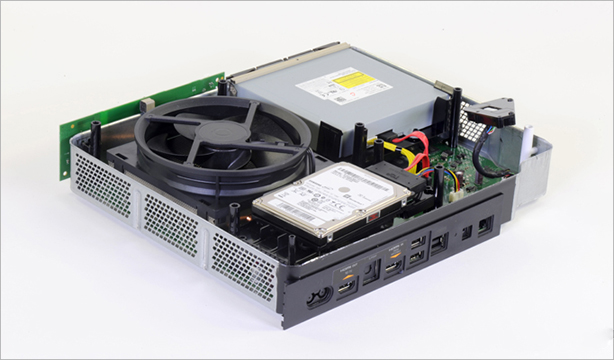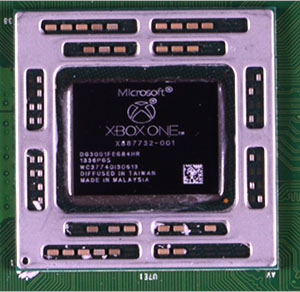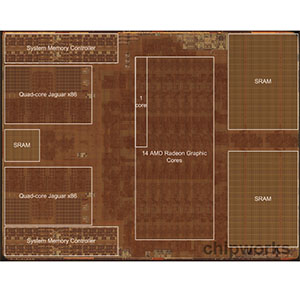
Xbox One – Architecture and Performance
Like the PS4, the Xbox One is in many ways a modest gaming PC in terms of raw hardware. Its x86 processor is a custom design by AMD but architecturally it is essentially an off the shelf AMD APU. Even more so because the Xbox One uses DDR3 RAM, whereas the PS4 employs GDDR5.
Inside, the chip has two quad-core Jaguar CPU modules running at 1.75GHz, which is 0.15Ghz faster than the identical cores of the PS4. Likewise the GPU portion of the chip runs faster than that of the PS4, clocking in at 853MHz compared to 800MHz. Both speed bumps are, however, an attempt to bridge a more fundamental performance gap arising not only from the slower RAM of the Xbox One but its lower-spec GPU. It houses 12 GCN Compute Units incorporating 768 stream processors compared to the PS4’s 18 Compute Units and 1152 stream processors.
Architecturally the Xbox One’s APU sits somewhere between the AMD HD 7850 and HD 7770 cards, a make-believe card that would’ve cost around £200 back in the early part of last year – not a bad amount of grunt for a £429 console.
There is one final piece to the chip puzzle, which somewhat explains why, despite in many ways being so similar in overall design and size, the Xbox One and PS4 chips differ so substantially on the GPU front, and that’s the presence of 32MB of SRAM on the Xbox One die. This provides a relatively large pot of extremely high speed cache to fuel the CPU and GPU. However, when a high-end GPU would normally expect to have access to several gigabytes of high-speed GDDR5 memory, as provided by the PS4, you see can see why the Xbox One is still considered the slower solution overall.
Not, of course that this necessarily means a huge difference in the real world. After all, the two systems run on different operating systems, something that also makes a direct comparison to equivalent PC hardware not entirely meaningful. The PS4 runs a Unix-derived operating system, using OpenGL 4.2 as its graphics API, while the Xbox One runs a 64-bit Windows NT 6.x kernel-based system, using DirectX 11 for its graphics API.
Nonetheless, the numbers so far do largely suggest the Xbox One does indeed trail on the graphical performance front. In three of the big name cross-platform titles that have launched with both consoles, the PS4 runs at a markedly higher resolution. Resolution isn’t the be all and end all but when all else is pretty much equal it is a noticeable difference.
These resolutions would’ve been chosen to ensure the games still ran at a smooth 60fps, which is one of the biggest upgrades over previous gen consoles that ran at 30fps. This also gives some indication as to where the new consoles sit regarding relative PC performance. In our recent analysis of Battlefield 4 performance it took cards of the calibre of the Nvidia GTX 780 and AMD R9 280X to hit those average framerates at 1080p with Ultra detail settings. In comparison the PS4 runs the game at 900p while the Xbox One runs it at 720p, with both appearing to have visuals equivalent to High detail settings on the PC version.

MSI MPG Velox 100R Chassis Review
October 14 2021 | 15:04











Want to comment? Please log in.